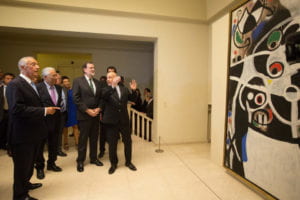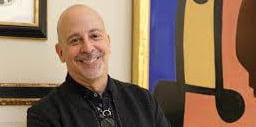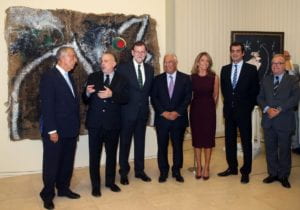NYU Madrid Site Director, Rob Lubar, associate professor of fine arts at the Institute for Fine Arts and Director of the Joan Miró Chair at the Universitat Oberta de Catalunya, has curated an exhibit on Miró in Oporto, Portugal. The exhibit, Joan Miró: Materiality and Metamorphosis, is on display at the Serralves Museum of Contemporary Art. We asked Professor Lubar for his thoughts on mounting the exhibition, and more broadly on Miró’s work.
When I was asked to curate the Portuguese State’s collection of 85 splendid works by the Catalan artist Joan Miró, I was delighted. I’ve dedicated a good part of my professional career to studying the art of Joan Miró. In 1988 I delivered my doctoral thesis at NYU’s Institute of Fine Arts on Miró’s early work. Since then, I’ve written extensively about Miró and am currently serving on the Board of Directors of the Fundació Joan Miró in Barcelona. I am also the Director of the Càtedra Miró at the Open University of Catalonia and the Research Director of the International Miró Research Group. The opportunity to curate the Oporto exhibition at the Serralves Museum, and to write a catalogue, has been one of the great pleasures of my academic career.
The collection, which contains a number of major works of historical importance and is uniformly of high quality, was acquired by the Portuguese State in an unusual way. The 85 works were purchased by a Portuguese bank as an investment opportunity. When the bank failed, it was rescued by the Portuguese State, to which the collection passed. Two and a half years ago, under a different government, the Portuguese State attempted to auction the collection at Christie’s London. There was a huge public outcry in Portugal and the collection was withdrawn from sale. At that time, I had been invited to deliver a plenary lecture before the sale. I was deeply disturbed that a collection of such great cultural value was being sold, as the decision struck me as politically driven. Fortunately, with the controversy that followed, the collection remained in Portugal but a final disposition for it was not made until recently. The current government decided to show the collection publicly in Portugal for the first time, and I was brought on board as curator. Not only is the exhibition at the Serralves Museum a huge success, but it was announced at the inauguration, in the presence of the Prime Minister of Portugal, the President of Portugal, the President of Spain, the President of Catalonia, the Mayor of Oporto and various Ministers of Culture that the collection would remain in Portugal and would find a permanent home in the Serralves Museum.
To have had the privilege to work with this great collection and to have had a hand in establishing a new museum in the magnificent city of Oporto has been enormously satisfying. With the Fundació Joan Miró in Barcelona and the Fundació Pilar i Joan Miró in Palma de Mallorca, the Serralves Miró collection forms a cultural triangle in the territories of the Iberian Peninsula. There will be numerous opportunities in the future for collaboration among these and other institutions, and I look forward to a close working relationship with the curators and administrators of the Serralves Museum.
About the Exhibition
Joan Miró: Materiality and Metamorphosis, which is on display through January 28, 2017, is comprised of 85 works by Miró owned by the Portuguese state, many of which have never been seen before by the general public, including six of his paintings on masonite produced in 1936 and six “sobreteixims” (tapestries) of 1973.

Robert Lubar discussing Miro with the President of Portugal, the Prime Minister of Portugal, and the Prime Minister of Spain at the exhibit opening in September.
The exhibition covers six-decades period – from 1924 to 1981, though it focused on the transformation of pictorial languages that the Catalan artist first developed in the mid-1920s. The exhibition considers his artistic metamorphoses across the mediums of drawing, painting, collage and work in tapestry.
Miró’s visual thinking and the ways in which he negotiates between optical and tactile modes of sensation is examined in detail, as are the artist’s working processes.
http://www.serralves.pt/en/activities/joan-miro-materiality-and-metamorphosis/

